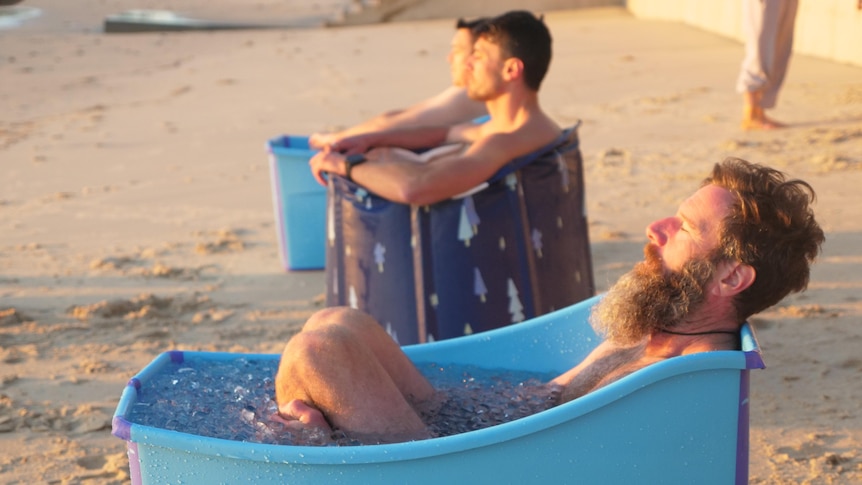Francine Nunnari admits jumping into a freezing cold ice bath on a crisp winter’s morning sounds “crazy.”
“Who would want to start doing ice baths in the middle of winter? I really thought it would just be me.”
But, to her surprise, a growing group of like-minded strangers have started joining her to brave the cold every Wednesday morning in New South Wales.
“It’s turned into something quite beautiful, meeting up with the community and pushing through self-limitations,” Ms Nunnari said.
Port Macquarie Beach, Breath and Ice Group gather at Port Macquarie’s popular Flynns Beach before sunrise.
Ms Nunnari guides them through peaceful, yet important, breathing exercises before preparing for the ultimate challenge.
“Cold represents stress; it’s a form of stress that a lot of us don’t like,” she said.
“It’s about facing a challenge rather than turning away from it.”
Each group member has a different motive for waking up at the crack of dawn and pushing their boundaries, but many said it was to improve their mental and physical health.
“You feel it physically, but really dealing with [the cold] is good for my mental health,” Hendo Longstaff said.
“For me, one of the biggest challenges was doing this form of practice in a community environment when I normally hide at home.”
A family challenge
For Michelle Jordan, the early morning meet-ups are a family activity with her husband and children.
“I find it a real challenge,” Ms Jordan said.
“I feel like I’ve achieved something and it’s building up more resilience in being able to do hard things.”
Her young daughter, Samaya, felt the same.
“It helps me get through the week and it feels nice afterwards,” she said.
Following the ice exposure, group members run into the ocean, which feels like a warm bath in comparison to the ice.
Not for everyone
Ice exposure and cold-water therapy was made popular by Dutch athlete Wim Hof and is practiced around the world.
Queensland University of Technology senior lecturer Jonathan Peak has conducted research on cold water immersion for athletes and said he understood why it was becoming popular within small communities.
“Initially there’s a little bit of shock when you get into the ice baths,” Dr Peak said.
“There’s the slowing of the heart rate and the activation of a sense of relaxation.
“What I think is happening is the cold-water immersion is putting these people into a meditative state.”
Dr Peak said more research was needed on its effects and potential risks for the general population, and recommended anyone with a pre-existing heart condition consult a health professional before participating.
Attendees feel ‘invigorated’
Group members aimed to submerge themselves in the bath for two minutes, yet local resident Ian Goldspink endured the ice for four.
“It felt invigorating — I loved it,” Mr Goldspink said.
For surf and yoga teacher Lauren Enfield, immersing herself in chilly water is a daily occurrence.
“I get a lot of ‘stoke’ in my life through surfing, through yoga, through nature, through family,” she said.
“An ice bath is something different, so it gives me the same sense of joy and release all day but I’ve done it in a different way that’s challenging.”
Ms Enfield believed other regional communities should embrace the weekly ice bath catch-ups.
“I think communities can benefit, not only from that changing mindset, but the gathering of the community,” she said.
Ms Nunnari could not agree more.
“Healing comes from connection,” she said.
“I can see this happening within the workplace, in schools, within every community and micro community.”
Ms Nunnari added that she had seen clear benefits.
“There’s the challenge, there’s the resistance, there’s overcoming that, pushing self-limiting beliefs, self-awareness, all of that,” she said.
.
